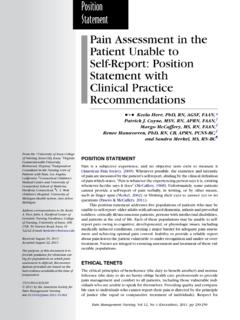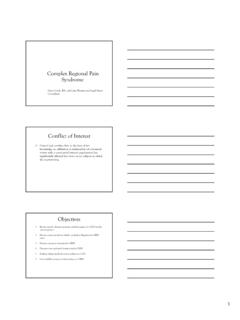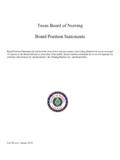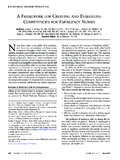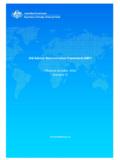Transcription of American Society for Pain Management Nursing …
1 From the *Swedish CovenantHospital, Chicago, IL; Hospice Care ofthe Low Country and Coastal Painand Spine Center, Bluffton, SC; UCLAS chool of Nursing , Los Angeles, CA; James A. Haley VeteransAdministration Medical Center &University of South Florida, Tampa,FL;kMatteliano Pain RehabilitationCenter, Buffalo, NY;{HorizonPharma, Deerfield, IL; **FairviewRidges Hospital, Burnsville, MN; University of Michigan AddictionTreatment Services, Ann Arbor, MI; Doernbecher Children s Hospital/Oregon Health & Science University,Portland, correspondence to BarbaraSt. Marie, PhD, ANP, GNP, Supervisor,Pain and Palliative Care, FairviewRidges Hospital, Burnsville, MN55337. June 29, 2012;Accepted July 1, $ 2012 bythe International NursingSociety on Addiction (IntNSA) andthe American Society for Pain Man-agement Nursing (ASPMN) Society forPain ManagementNursing PositionStatement: PainManagement in Patientswith Substance UseDisorders---June Oliver, MSN, CCNS, APN/CNS,*Candace Coggins, MS, MA, RN-C, ACHPN, PMHNP-BC, Peggy Compton, RN, PhD, FAAN, Susan Hagan, MSN, ARNP-C, RN-BC, Deborah Matteliano, PhD, ANP, FNP, RN-BC,kMarsha Stanton, PhD, RN,{Barbara St.}}
2 Marie, PhD, ANP, GNP, RN-BC,**Stephen Strobbe, PhD, RN, NP, PMHCNS-BC, CARN-AP, and Helen N. Turner, DNP, RN-C, PCNS-BC, FAAN -ABSTRACT:The American Society for Pain Management Nursing (ASPMN) hasupdated its position statement on managing pain in patients withsubstance use disorders. This position statement is endorsed by theInternational Nurses Society on Addictions (IntNSA) and includesclinical practice recommendations based on current evidence. It is theposition of ASPMN and IntNSA that every patient with pain, includingthose with substance use disorders, has the right to be treated withdignity, respect, and high-quality pain assessment and to identify and treat the concurrent conditions of pain andsubstance use disorders will compromise the ability to treat eithercondition effectively.
3 Barriers to caring for these patients includestigmatization, misconceptions, and limited access to providersskilled in these two categories of disorders. Topics addressed in thisposition statement include the scope of substance use and relateddisorders, conceptual models of addiction, ethical considerations,addiction risk stratification, and clinical recommendations. 2012 by the International Nursing Society on Addiction (IntNSA) andthe American Society for Pain Management Nursing (ASPMN)Pain Management Nursing ,Vol 13, No 3 (September), 2012: pp 169-183 PositionStatementPOSITION STATEMENTThe American Society for Pain Management Nursing (ASPMN) and the International Nurses Society on Ad-dictions (IntNSA) hold the position that patients withsubstance use disorders and pain have the right to betreated with dignity, respect, and the same quality ofpain assessment and Management as all other and effective care of patients with substance usedisorders includes maintaining a balance between theprovision of pain relief, monitoring for appropriateuse of prescribed medications and other substances,and recommendations for viable treatment alterna-tives.
4 Nurses are well positioned and obligated to advo-cate for pain Management across all treatment settingsfor patients at various points along a continuum of sub-stance of Substance Use and Related use and related disorders arecommon in our Society . Illicit use of controlled sub-stances is a leading category of medication 2009, the number of Americans reporting currentnonmedical use of prescription drugs exceeded thenumber using cocaine, heroin, hallucinogens, and in-halants combined (Substance Abuse and MentalHealth Services Administration [SAMHSA], 2010a). Ac-cording to theSubstance Abuse and Mental HealthServices Administration (2011), in 2010 an million Americans ( of the population) aged$12 years reported using an illicit substance in the pre-vious month.
5 Approximately 7 million of these individ-uals met diagnostic criteria for a drug use disorder, andan estimated million persons reported that they hadused prescription pain relievers in a nonmedical or non-prescribed manner. Sixty-six percent of those individ-uals obtained these medications from a friend orrelative, and almost 80% of those friends or family mem-bers had obtained their medications from a single pre-scriber. More than one-third of those who had usedthese medications illicitly ( million persons) wereclassified as having abused or been dependent on thesesubstances (SAMHSA, 2011).In the pediatric population, prescription opioidsare the most commonly used drugs for nonmedical pur-poses. Too often, children and youths mistakenly as-sume that prescription medications are safer thanstreet drugs to relieve discomfort or to feel good.
6 Non-medical users can be divided into two distinct groupsof self-treatment versus other reasons for use. In a studyof adolescents byBoyd, McCabe, Cranford, and Young(2006), 69% reported pain control for complaintssuch as headache or menstrual cramps as the primaryreason for nonmedical opioid use. This may be more ap-propriately viewed as self-medicating or opioid misuse,which is associated with a lower risk for subsequentopioid abuse or dependence. A small minority (11%) re-ported using prescription opioids solely to get high. The National Center on Addiction and Substance Abuseat Columbia University (NCASA, 2011) has called ado-lescent substance misuse including alcohol, tobacco,and other drugs the nation s number-one health prob-lem. The number of high school students who reportedever having misused opioids increased significantlyfrom the beginning ( of 9th graders) to the endof high school ( of 12th graders), with almost13% having misused prescription opioids in their life-time and currently misusing these substances(NCASA, 2011;Frese & Eiden, 2011).
7 Diversion of pre-scription opioids is also common among pediatric non-medical users. A full 75% of youths report borrowingmedications from family or friends instead of seeinga health care sometimes overlooked, abuse/misuse ofprescribed medications occurs in all ages, includingmiddle-aged and older adults. Additionally, as the pop-ulation ages, experts predict that prescription drugabuse among the elderly will also rise significantly(Martin, 2008). In people aged$50 years, an increaseof up to 190% in nonmedical use of psychotherapeuticdrugs is projected over two decades from 911,000in 2001 to million in 2020 (Colliver, Compton,Gfroerer, & Condon, 2006).Over the past decade, there have been steadily ris-ing rates of hospital admissions for the treatment ofprescription opioid misuse.
8 Visits to hospital emer-gency departments (EDs) involving the nonmedicaluse of prescription analgesics rose 111%, more thandoubling the number of visits from 2004 to top three medications mentioned in these visitswere oxycodone, hydrocodone, and methadone prod-ucts (SAMHSA, 2010b). Additionally, unintentionaldeaths related to opioids have reached epidemicproportions (Centers for Disease Control andPrevention, 2010,2011). The risk of death is magnifiedwhen opioids are taken in combination with alcohol,sedatives, hypnotics, and total cost of substance misuseto federal, state, and local governments is estimated tobe a staggering $ billion per year (NCASA, 2011).The National Prescription Drug Threat Assessmentsurvey found that controlled prescription diversion oc-curs most often through doctor shopping, prescriptionfraud, and theft (National Drug Intelligence Center[NDIC], 2010).
9 The estimated cost of controlled pre-scription diversion is $ billion per year to public170 Oliver et private medical insurers, and this cost is passed onto consumers through higher health insurance pre-miums. In an effort to address some of these problems,prescription monitoring programs (PMPs) have beenestablished in the majority of states, although no na-tional system exists. PMPs have been shown to reducethe number of prescriptions illicitly obtained throughdoctor shopping (NDIC, 2010).Implications for Health examining the in-tersection of persistent pain and addiction, problem-atic drug-taking behaviors have been identified in upto 40% of all pain patients; much fewer appear to actu-ally have a substance use disorder. An estimated 20% ofthose individuals demonstrated behaviors suggestive ofsubstance abuse, and only 2% 5% demonstrated behav-iors indicative of the disease of addiction (Webster &Webster, 2005).
10 Failure to identify and treat the concur-rent condition of pain and addiction compromises theability to treat either condition effectively (Gourlay,Heit, & Almahrezi, 2005). The nurse s role is to advo-cate for the individual needs of the pain patient inthe context of substance use disorders. Nurses andother health care providers may have personal beliefsand experiences that can negatively affect the abilityto provide effective care for patients who have sub-stance use disorders, including those with pain. Allinterdisciplinary health care team members are en-couraged to engage in therapeutic discussions witheach other to openly explore beliefs and attitudes re-garding these conditions (McCaffery, Grimm, Pasero,Ferrell, & Uman, 2005).Barriers to is rooted in shame and guilt, and it in-terfereswith the development of trust and the establish-ment of a therapeutic relationship.




